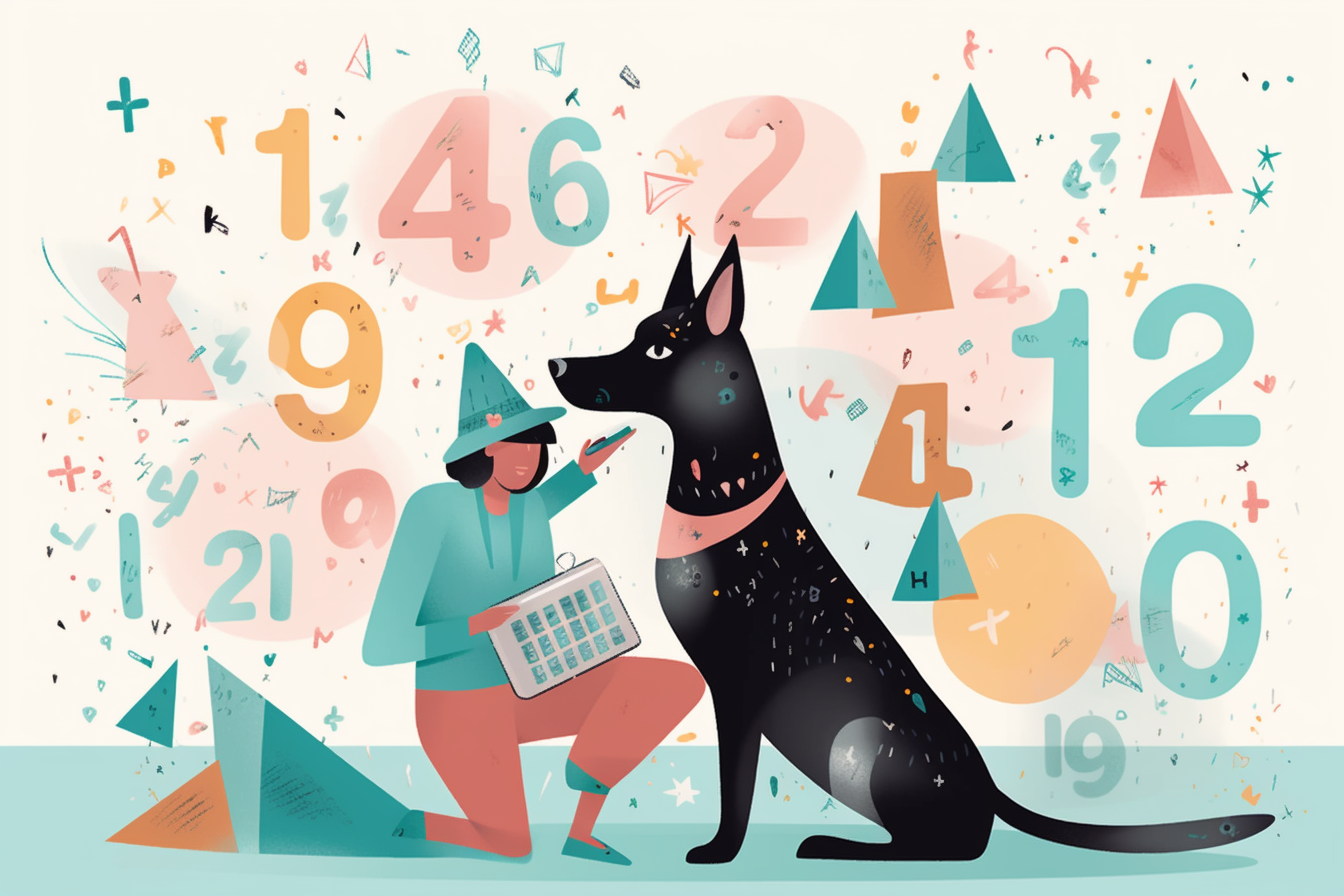
Picture this: your dog, a full-fledged member of the family, celebrates their birthday, and you’re curious just how old they really are in human years. You’ve probably heard that one dog year equals seven human years – but is it actually that simple?
As an expert on canine aging and dog-to-human age conversion, I’m here to tell you that there’s more to the story than meets the eye. In fact, calculating your furry friend’s true ‘human’ age can be as intricate and fascinating as unwrapping a chew toy stuffed with treats.
Also, check out our other tools;
Dog Calorie Calculator Online Tool
Dog Breed Maximum Age Calculator
So why should we care about accurately converting our dogs’ ages into human years? As doting pet parents who take pride in catering to every need of our four-legged companions, understanding their stage in life helps us better serve them.
Knowing your pup’s age provides insights into their behavior patterns, nutritional needs, exercise requirements, and health concerns specific to their breed and size. With these details at hand, we can tailor our love and support to ensure they live long, happy lives by our side – because isn’t that what all great pet owners strive for?
Our user-friendly ‘Dog Age in Human Years Calculator’ will become your go-to resource for unlocking these essential tidbits of information while strengthening the bond between you and your adored companion.
How Dogs Age Differently From Humans

When it comes to understanding how our beloved canine companions age, there’s more than meets the eye. Unlike humans, dogs experience significant variations in their lifespans and aging processes depending on factors like breed, genetics, environment, and healthcare needs.
As a dog age conversion expert, I’m here to help you navigate through these complexities and shed some light on common misconceptions surrounding dog age myths.
One aspect of the canine aging process that many people are often curious about is breed aging differences. Different breeds have unique characteristics that can impact their overall health and life expectancy. For example, smaller breeds typically enjoy longer lives compared to larger ones due in part to fewer joint issues and less strain on their internal organs. Beyond just size though, certain breeds inherit genetic predispositions towards specific health conditions which affect both puppy development stages as well as senior dog care requirements. Recognizing these distinctions is crucial for providing optimal support throughout your pup’s life.
In addition to acknowledging breed-specific factors when caring for your furry friend, it’s essential to be aware of general canine healthcare needs during different phases of life. Proper nutrition, regular exercise, dental hygiene maintenance – these all contribute significantly not only to an extended lifespan but also ensuring that those golden years are comfortable and enjoyable for your pet. Paying attention to subtle changes or emerging symptoms will allow you to adjust care accordingly; vigilance is key!
Now let us dive deeper into exploring the intricacies involved with decoding our pets’ true ages by discussing how we can better understand the dog age calculator next.
Understanding The Dog Age Calculator

Understanding the Dog Age Calculator is a fascinating journey into debunking aging myths and making meaningful breed comparisons. As pet owners, we’re often eager to learn about our furry friends’ lifespans and how best to provide age-related care throughout their lives. With this tool at your fingertips, you can accurately estimate your dog’s human years based on factors like size, breed, and age, allowing for more tailored care that meets both puppy development milestones and senior dog needs.
The calculator uses an innovative approach by breaking down key aspects of canine aging:
- Size categories: small, medium, large, and giant breeds all have different growth patterns and life expectancies.
- Small dogs generally live longer than larger breeds.
- Giant breeds may experience accelerated aging in comparison to others.
- Breed-specific considerations: each breed has its unique genetic makeup which affects overall health and longevity.
- Some purebreds are predisposed to specific health issues due to selective breeding (e.g., hip dysplasia).
- Mixed-breeds or ‘mutts’ might exhibit hybrid vigor – increased vitality from diverse gene pools.
- Life stages: puppies mature rapidly within the first year but slow as they reach adulthood; older dogs require special attention as their bodies begin showing signs of wear.
- Puppyhood is characterized by rapid physical growth and mental development.
- Senior dogs need extra support with nutrition, exercise modifications, and preventive healthcare measures.
As a devoted pet owner passionate about educating yourself on the intricacies of canine aging, understanding the Dog Age Calculator empowers you with crucial knowledge. It allows you to better understand your dog’s individual needs while providing them with customized love and care throughout their entire lifespan.
Now that we’ve explored how the calculator works let’s delve deeper into why it’s essential to know your dog’s human age for optimal caregiving experiences.
Why It’s Important To Know Your Dog’s Human Age

Knowing your dog’s human age is essential for various reasons, one of which is to better understand their health and wellness needs. As dogs grow older, they become more susceptible to age-related ailments such as arthritis, dental issues, and heart problems. Being aware of your furry companion’s equivalent human age helps you provide the appropriate senior care necessary to maintain their quality of life. Moreover, grasping an understanding of breed lifespan allows you to customize preventive measures that promote longevity.
A significant aspect of caring for a dog in its corresponding human years involves tailoring their nutrition and exercise routines according to their stage in life. Younger dogs require different dietary compositions than seniors; likewise, engaging them with suitable physical activities ensures optimal development and aging prevention. The table below illustrates this correlation:
| Age Group | Nutrition Impact | Exercise Influence |
|---|---|---|
| Puppy | High-quality protein for growth | Moderate playtime & socialization |
| Adult | Balanced diet | Regular exercise & mental stimulation |
| Senior | Lower calorie intake | Gentle exercises & joint support |
By being informed about your dog’s human age, you empower yourself with valuable insights into how best to serve their individual needs throughout each phase of life. With proper attention given to factors like nutrition impact and exercise influence on their well-being, you can contribute positively towards extending your pup’s life expectancy while enriching it simultaneously.
So now that we have established why knowing our pet’s human age plays a crucial role in providing exceptional care let us delve deeper into using the dog age calculator effectively!
How To Use The Dog Age Calculator

They say you can’t teach an old dog new tricks, but when it comes to understanding your dog’s age in human years, there is always more to learn. Using a dog age calculator not only helps you determine your furry friend’s equivalent human age but also allows you to be proactive with their health and care requirements.
To make the most of this valuable tool, follow these simple steps:
- Input your dog’s breed or size category
- Enter their current chronological age (in months or years)
- Take note of the calculator accuracy for different breeds and sizes
- Look out for any aging signs that may indicate adjustments needed in their care regimen
- Consider adopting age related care measures like senior dog nutrition, exercise recommendations, and vaccination schedules
Breed variations play a crucial role in determining how quickly dogs age. Consequently, using a calculator tailored specifically for your canine companion ensures higher accuracy levels compared to generic calculators.
Understanding your dog’s life stage will enable you to provide them with proper preventative healthcare and ensure they are living their best lives. Being aware of the specific needs of older dogs is essential as they enter their golden years; from making changes in diet to adjusting training routines accordingly.
With knowledge on hand about senior dog nutrition and appropriate exercise recommendations, owners can help maintain optimal health throughout each unique phase of their pet’s life. By keeping up-to-date with regular veterinary visits and recommended vaccination schedules, you’re ensuring that your beloved pup receives all necessary support required at every step along the way.
Armed with this information on how to use our handy Dog Age Calculator effectively, we invite you now to explore what factors affect your precious pooch’s true age in human years further!
Factors Affecting Your Dog’s Age In Human Years
As you seek to understand your dog’s age in human years, it’s essential to consider various factors that affect their overall aging process.
One of the most significant aspects is genetic influences and breed variations. Different breeds have unique lifespans due to inherited traits, which means that a small-sized dog may live longer than a larger one. Additionally, size differences play an important role; smaller dogs tend to age slower compared to their larger counterparts.
Another factor worth considering is the impact of exercise and nutrition on your furry friend’s health. A well-rounded diet filled with essential nutrients will not only contribute to maintaining a healthy weight but also support longevity in your canine companion. Exercise keeps them fit, strengthens their muscles and joints, and helps alleviate stress – all crucial components for a happy life as they progress into seniority.
Prioritizing preventative care through regular veterinarian visits can help detect potential issues early on, ensuring proactive steps are taken towards addressing any concerns before they escalate.
Lastly, providing proper senior dog care becomes increasingly vital as your pet ages. This includes adjusting their diet for specific nutritional requirements during this phase of life and making accommodations for decreased mobility or cognitive function changes.
By keeping these factors in mind, you’ll be better equipped to estimate your dog’s age in human years accurately while optimizing their quality of life throughout each stage. Now that we’ve explored these key considerations let’s delve deeper into how you can determine your dog’s equivalent human age by examining different methods available today.
How To Estimate Your Dog’s Age In Human Years
Understanding your dog’s age in human years is essential for providing them with the best care possible. Knowing their age helps you anticipate and address age-related illnesses, tailor age-appropriate activities, and plan for senior dog care. Puppy growth stages and aging prevention also play a crucial role in ensuring optimal health throughout your furry friend’s life. However, calculating a dog’s age isn’t as simple as multiplying by seven; various factors such as breed variations and individual differences affect their lifespans.
To estimate your dog’s age in human years, consider its size and breed. Smaller breeds tend to live longer than larger ones. For example, Chihuahuas can live up to 18 years while Great Danes have an average lifespan of around 8-10 years. Therefore, when comparing these two breeds’ ages in human terms, one year for a Chihuahua may be equivalent to three or four years for a Great Dane.
Furthermore, mixed-breed dogs often benefit from ‘hybrid vigor,’ which means they are less prone to genetic diseases specific to purebred dogs and could enjoy longer lives. Calculating your canine companion’s age requires attention to details like weight changes over time, dental condition, graying hair patterns on muzzle or body, eyesight abilities or cloudiness levels – all these signs give some indication about how old Fido might really be!
So keep an eye out for subtle cues that provide insight into your pet’s true biological clock ticking away inside them! With this knowledge at hand (or paw?), let us now move forward onto addressing common questions concerning dog age calculators awaiting our expertise.
Common Questions About Dog Age Calculators
Now that you have a better understanding of how to estimate your dog’s age in human years, it’s crucial to address some common questions and concerns related to this topic. Many pet owners are curious about the accuracy of these calculations, breed differences affecting aging, and how to properly care for their dogs as they reach various life stages. Let’s dive deeper into these important aspects of canine aging.
- Dog Age Myths: Some people believe that simply multiplying a dog’s age by seven will give an accurate representation of their age in human years. However, this is not entirely true; factors such as size and breed can significantly impact a dog’s aging process.
- Breed Differences & Aging Signs: Different breeds have varying life expectancies and may show signs of aging at different rates. It is essential to be familiar with your specific breed’s characteristics so you can recognize life stage changes and provide appropriate senior dog care when needed.
- Age-Related Diseases & Pet Longevity: As our furry friends grow older, they become more susceptible to certain age-related diseases like arthritis or heart issues. By being proactive in recognizing symptoms and seeking veterinary advice early on, we can help improve our pets’ quality of life while potentially extending their lifespan.
As we continue to explore the fascinating subject of canine aging, remember that taking good care of your best friend goes beyond merely knowing their estimated age in human years. Becoming more knowledgeable about potential health challenges and providing tailored support based on your dog’s unique needs is key to ensuring they live a happy, healthy life well into their golden years. Up next, we’ll address some common misconceptions surrounding dog age calculators – stay tuned!
Common Misconceptions About Dog Age Calculators
One of the most significant aspects to explore regarding dog age calculators is understanding common misconceptions that surround them. To serve our canine companions better, it’s vital to clear up these misunderstandings and provide accurate information about their aging process. Misconception origins often stem from oversimplification or misinformation, which can lead people to believe in faulty aging myths.
The first myth we need to address is the belief that one year for a dog equals seven years for humans. While this may be an easy way to remember things, it doesn’t account for breed variations and size factors that contribute significantly to how dogs age. For example, smaller breeds tend to live longer than larger ones, meaning they also have different rates when converting their ages into human years.
Debunking myths like this will help ensure age calculator accuracy by taking into consideration crucial elements such as canine development stages. As we strive towards providing better care for our beloved pets, acknowledging these misconceptions allows us to make informed decisions based on factual information rather than relying on outdated beliefs. With a clearer understanding of how dogs truly age, you’ll now be equipped with the knowledge necessary to utilize dog age calculators more effectively.
Next up, let’s dive into some helpful tips for using the dog age calculator that takes all these critical factors into account while ensuring your pet receives the best possible care tailored specifically just for them!
Tips For Using The Dog Age Calculator
Savvy seekers of canine calculation, it’s time to take a closer look at the dog age calculator and how best to utilize this helpful tool. To ensure you’re getting accurate results that will help guide your age-related care decisions for your furry friend, there are several factors to consider when using the calculator.
Let’s dive into some crucial tips that can help you maximize its potential while debunking myths about breed variations and size considerations.
Calculator accuracy is critical in determining your dog’s true age in human years, but remember that no tool is perfect. There could be minor discrepancies between different calculators or even slight deviations from reality; however, with proper use, these tools offer valuable insights into our pets’ lives.
The key to unlocking accurate results lies in considering diverse aspects such as breed variations and size considerations. For instance, larger breeds tend to have shorter lifespans than smaller ones due to their accelerated growth rates during puppyhood. Hence, accounting for these differences while calculating your dog’s age will lead towards more precise conclusions on matters related to canine longevity.
Now that you’ve taken note of the importance of both breed variation and size consideration let us delve deeper into providing our senior dogs with exceptional care based on the knowledge we’ve gathered through the calculator. By gaining an understanding of where they stand in terms of their equivalent human years, pet owners become better equipped to address specific health needs and implement senior dog tips aimed at improving quality of life throughout their golden years.
As you continue reading about the benefits of knowing your dog’s age in human years, bear in mind how empowering this information can be – not only for yourself but also for enhancing the well-being of your cherished companion.
Benefits Of Knowing Your Dog’s Age In Human Years
Understanding your dog’s age in human years offers several aging benefits that contribute to enhancing their overall well-being. By converting your furry friend’s age, you not only forge a deeper connection with them but also make informed decisions regarding their health monitoring and care. As a responsible pet owner, knowing your dog’s age in human years aids in making timely dietary adjustments, exercise planning, mental stimulation activities, and veterinary visits tailored specifically to their life stage.
To ensure the best possible care for your canine companion, consider these four essential factors when determining their needs based on their age:
- Health Monitoring: Regular check-ups and preventative measures are crucial for dogs of all ages; however, older dogs may require additional attention to address any potential age-related issues.
- Dietary Adjustments: Nutritional needs evolve as your dog grows older – puppies need different nutrients than seniors. Providing appropriate food for each life stage can significantly impact their overall health.
- Exercise Planning: Physical activity requirements vary by breed and age. Understanding how old they are in human years helps determine the most suitable form of exercise to keep them fit while avoiding excessive strain or injury.
- Mental Stimulation: Keeping your dog mentally engaged is just as important as physical wellness. Appropriate toys and games should be chosen according to their cognitive ability at each stage of development.
The value of calculating our beloved pets’ age in human years goes beyond simple curiosity; it empowers us to provide optimal care throughout every phase of their lives. Lifespan awareness allows us to cater to our fur babies’ specific needs better, ensuring that they remain healthy and happy companions.
So take advantage of this knowledge and enhance both the quality of life for your furry friend and the bond between you two – after all, serving others (even if they’re our adorable pets) brings immense satisfaction!
Frequently Asked Questions
Can A Dog’s Breed Significantly Impact Its Age In Human Years?
It’s a widely known fact that the earth revolves around dogs, and when it comes to breed lifespan and aging variability of our furry friends, there is much more than meets the eye.
Genetic factors play an essential role in determining how different dog breeds age, with some breeds having naturally longer lifespans due to their ancestral lineage.
Inbreeding consequences can significantly impact a breed’s longevity, leading to certain health issues that might reduce their overall life expectancy.
Mixed breeds often benefit from genetic diversity, potentially giving them an advantage over purebreds regarding longevity and health.
While breed stereotypes may lead us to believe that smaller dogs always live longer than larger ones, this isn’t always the case—several exceptions prove otherwise.
Ultimately, understanding your dog’s unique makeup and history will help you better serve their needs throughout their lifetime as they transition through various stages in ‘human years.’
How Does A Dog’s Size And Weight Influence Its Age In Human Years?
Size variability and weight fluctuations in dogs can greatly influence their growth patterns, aging process, and ultimately, the conversion of their age into human years.
As a dog age conversion expert, it’s important to note that factors such as metabolic rate, genetic factors, and breed characteristics play crucial roles in shaping these differences among our canine companions.
Larger breeds tend to have faster initial growth rates but may experience shorter overall lifespans; on the other hand, smaller breeds often exhibit slower early development yet enjoy longer lives.
This disparity makes utilizing a one-size-fits-all approach to lifespan predictions less accurate and highlights the importance of considering each individual dog’s unique attributes when determining their equivalent age in human years – an essential aspect for those who are dedicated to serving the needs and well-being of our beloved pets.
Are There Any Specific Health Conditions That Can Affect A Dog’s Age In Human Years?
As the old saying goes, ‘an ounce of prevention is worth a pound of cure,’ and this rings true when it comes to certain health conditions that can influence a dog’s age in human years.
Genetic predispositions play a significant role in determining your dog’s vulnerability to chronic illnesses, hormonal imbalances, and other potential health issues.
Early neutering can also have an impact on their overall lifespan, depending on factors such as breed and size.
Furthermore, vaccination impacts should not be brushed under the rug; they’re crucial for maintaining optimal health throughout your furry friend’s life.
Don’t forget about dental hygiene – poor oral care has been linked to shorter lifespans in dogs due to underlying medical problems caused by infection or inflammation.
Lastly, preventative care is key: regular checkups with your veterinarian will ensure any concerns are addressed promptly so you can continue serving your four-legged companion through thick and thin while keeping them feeling young at heart!
Can A Dog’s Diet And Exercise Routine Impact Its Age In Human Years?
Absolutely, a dog’s diet and exercise routine can significantly impact its age in human years.
As a dog age conversion expert, I recommend providing your furry friend with dietary supplements to ensure they’re receiving essential nutrients, while also being mindful of food allergies that may require tailored diets.
Exercise variety is crucial for maintaining physical health and mental stimulation, so try incorporating new activities into your pet’s routine.
Don’t forget the importance of hydration as it plays a vital role in overall wellness.
Dental care should never be overlooked either; keeping their teeth clean helps prevent diseases that could affect their lifespan.
Lastly, regular checkups at the vet are essential for detecting any potential health concerns early on, allowing you to best serve your canine companion by ensuring they live a long and healthy life!
How Do Environmental Factors, Such As Exposure To Toxins Or Stress, Influence A Dog’s Age In Human Years?
Environmental factors play a significant role in your furry friend’s overall health and longevity, with toxin avoidance and stress management being crucial components.
Urban living can expose dogs to various pollution effects, including secondhand smoke and chemical exposure from household products or outdoor contaminants. These harmful elements contribute to the acceleration of aging, potentially impacting their age when converted into human years.
Additionally, noise pollution is known to cause stress in pets which may also affect their lifespan negatively.
As a dog age conversion expert, it’s essential to remember that providing a clean environment and implementing proper stress management techniques for our four-legged companions not only helps them lead happier lives but could also positively influence their age progression as compared to human years.
Conclusion
In conclusion, there’s no one-size-fits-all answer when it comes to calculating a dog’s age in human years.
Factors like breed, size, weight, health conditions, diet, exercise routine, and environmental factors can all play a significant role in determining your furry friend’s true age.
As the saying goes – you can’t teach an old dog new tricks – but understanding how these various aspects influence our canine companions’ aging process allows us to provide them with the best possible care throughout their lives.